classification of Soil Movements -Causes and Recommended Suitable Foundations
There are various types of soil movements that may occur disregard of the stresses imposed on the ground by foundations. So, it is necessary to consider adequate measures against such ground movements so as to prevent foundations from failure.
Ground movement mitigation may involve the deepening of foundation to the soil that does not suffer such movements or construct a type of foundation that is able to take considerable amount of movements without causing structural damages.
In this article, various types of ground movements and suitable types of foundations are discussed.
Types of Soil Movements, Causes and Recommended Suitable Foundations
- Soil movements
- Ground movements due to seepage of water and surface erosion
- Ground movements due to vibrations
- Ground movements due to hillside creep
- Ground movements due to mining subsidence
- Foundation on filled ground
- Machinery foundations
Soil Movements
There are several factors that cause the movement of soils which are discussed in the following sections:
Wetting and Drying of Clay Soil due to Moisture Content Changes
There are types of soil that undergo considerable swelling as moisture content is increased and experience shrinking when it is lose the water.
This variation in soil volume leads to the development of cracks during dry season and these cracks would be closed during wet season in addition to rising and falling of ground during wet and dry season respectively
It is claimed that such soil movement is more obvious and greater in grass soil than others without grass.
Swelling and shrinkage of clay soil can be considerably damageable to buildings that built on shallow foundation specifically where the clay beneath the foundation is heavy. So, it is recommended to consider pad or strip foundation with a depth range from 0.9m to 1.2m for low rise structures.
It may be argued that, such excavation depth for the entire structure is costly, that is why allowing movements between foundation walls and ground floor slabs are advised.
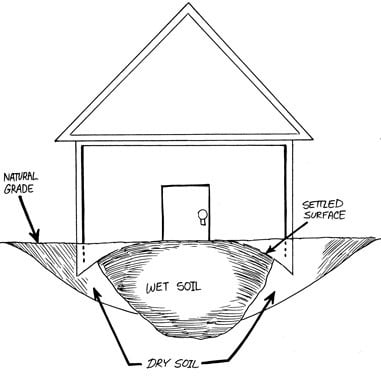
Effect of Vegetation on Swelling and Shrinking of Soil
Generally, the presence of trees and vegetation lead to dry soil to a depth ranges from 3m to 5m. It is reported that root of tree spread a radius that is at least equal to its height and vegetation and trees have caused substantial damages to structures.
Shrinkage of clay soil caused by trees occurs both horizontally and vertically so it is required to consider necessary measures against soil settlement and the force that tend to tear the foundation.
It is proven that such movement after the removal of tree in the area may last for 20 years, so it is recommended to use pile foundation in areas in which trees are growing.
Shrinkage of Clay due to High Temperature
Commonly, clay soil beneath the foundation of furnaces, kilns, and boilers suffer substantial drying and hence serious shrinkage would occur. It is reported that the heat from kiln had reached up to 20m depth of clays soil.
So, it is advised to provide insulation between the foundation of such structures that produce great amount of heat and the clay soil beneath the foundation so as to prevent severe shrinkage of the soil.

Ground Movements due to Seepage of Water and Surface Erosion
Water seepage and surface erosion are commonly cause problems in sandy soil. internal erosion of soil occurs when groundwater seeps into the culvert or sanitary sewer system, which are damaged, and fine soil particles are carried along the movement of groundwater.
Degradation of soluble components of industrial solid waste material due to water seepage is highly likely, and this lead to loss of soil beneath the foundation and eventually the structure might fail. Such undesired event may happen in mining subsidence areas.
It is reported that water seepage has cause problems in areas where dry loose sand and loess soil. It is advised to compact such soil using heavy hammer in areas where the depth of such soil is less than 6m, and pile driving or blasting are advised for region where the depth of soil is greater than 6m.
With regard to surface erosion, it may occur due to the loss of material by flowing water or strong winds.
Fine sands, silts, and dry peats are types of soils which are susceptible to surface erosion caused by strong wind. This may undermine the foundation of the structure unless it is tackled properly by deepening the foundation to 0.3m and growing vegetation in the area or covering the surface using crushed stone, gravel, or clay soil.
As far as surface erosion caused by flowing water is concerned, this type of erosion can cause serious problem specifically in regions that are prone to heavy rainfalls. It is claimed that, ordinary depth of foundation, which is between 0.9 to 1.2m, is not sufficient to tackle such problem, so it is required to provide necessary drainage and paving or other surface protection technique.
It is recommended to employ pile foundation in such cases to avoid foundation problems and subsequent failure of heavy structures.

Ground Movements due to Vibrations
Commonly, different vibration equipment is used to compact recently placed concrete and sandy soils. When poured concrete is exposed to vibration, its density would increase in addition to settle considerably.
Similarly, structural foundation constructed on sands or sandy gravels would suffer the same phenomenon when it is subjected to vibrations.
There are various sources from which foundations can receive vibrations for example rock blasting, out of balance machinery, drop hammer, driving pile, and earthquakes.
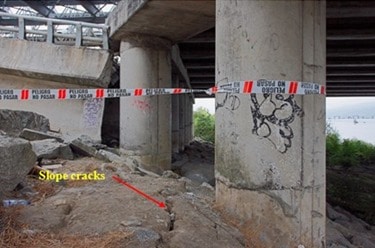
Fig.: Soil Movement due to Vibration Caused by Earthquake
It is proven based on laboratory test, field experiment, and past structural damage observations that substantial and extreme settlements due to vibrations is caused by high frequency vibrations ranges from 500-2500 impulse per minute.
Measures proposed to tackle detrimental effects of vibrations on structural foundations includes vibrating sands, taking necessary precautions to decline pile driven foundation effect on surrounding structure built on sands.
For foundation structure supporting vibratory machines, it is recommended to use special vibrating damping device for vibratory machines that supported by foundation structure or excavating foundation till soil layer which is not sensitive to vibration such as soil is realized.
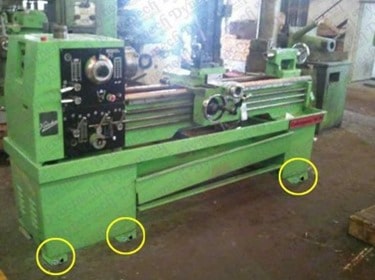
Fig. Providing Dampers to Absorb Machine Vibrations
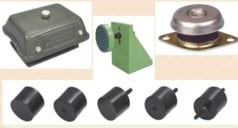
Fig.: Anti-Vibration Mounts
Ground Movements due to Hillside Creep
Naturally, shallow thickness of soils at specific hillside slopes would slid and slip down and such movement commonly occurs over a long period of time and there are sign that indicate such movements for example leaning trees.
It is recommended to dug trial pits on sloping slides so as to explore the likelihood of debris, which have been brought down from higher places, movements in the future.
It should be known that the structural weights does not have obvious influence on the mass of slipping ground and hence foundation loading would not affect the sliding safety factor, but construction process might influence slope stability.
It should be remembered that vegetation at the area would improve stability and its removal during construction operation for clearance purposes would diminish that advantage.
Proper measures that may be considered to answer such problem is varied according to the type of hillside slope soil. For example, instability of rocky hillside slopes can be tackled using grouting or rock bolting but it is recommended to avoid construction in such places if clay soil is present since its remediation is almost impossible or the foundation of the structure should be designed and constructed to move entirely as single object.
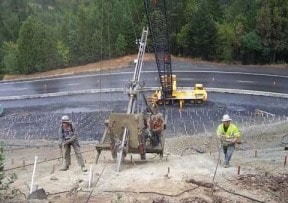
Fig.: Bolting Slopes to Obtaining Stability

Fig: Leaning of Tress due to Hillside Creep
Ground Movements due to Mining Subsidence
The presence buried old mining locations could pose serious problems for the foundation of structure. The majority of such positions cannot be positioned and several methods such as geophysical technique have been used to find out such vulnerabilities but the only effective technique is trenching across the construction site.
The magnitude and lateral range mining subsidence is based on the technique used to extract material. For example, dredging, pumping, or mining, and different approaches have been employed at certain time. Foundation issues caused by concealed mining have been encountered many times in the United Kingdom.
It is reported that, if the thickness of soil over the area from which materials were extracted is deep then it would not influence the structure otherwise the foundation would suffer considerable deterioration.
Figures above and below illustrates soil movement due to inactive coal mining and its influence on the structure at and around the area.
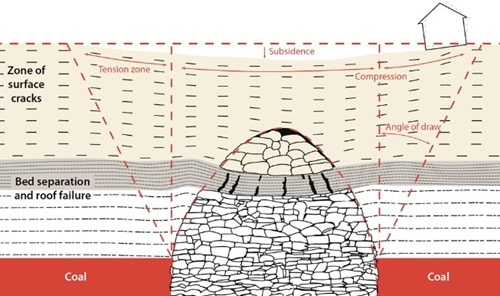
Fig.: Subsidence Above Inactive And Unidentified Coal Mining

Fig: Effect of Subsidence on the Building at the Site
There are number of recommendation that needs to be considered in order to protect structure at mining subsidence areas. The structure should be fully rigid or flexible and simple spans along with flexible superstructure is advised when it is possible. Shallow found such as raft foundation is the best choice to protect compression and tensile fracture in the ground.
There are other methods which can be used to protect structure in subsidence areas. For example, superstructure or substructure articulation, provide hydraulic jacking under the wall or columns, and dig trenches around the structure to release compression strain.
Foundation on Filled Ground
Foundations constructed on filled ground may suffer damage due to filled ground settlement. There are three major factors that cause of ground fill settlements includes consolidation of compressible fill under foundation weight, ground fill degradation due to its own weight, and consolidation soil layer beneath fill under its own weight plus the weight of the fill.
Soil movement due to consolidation of compressible ground fill is negligible if the foundation is not heavy otherwise the movement needs to be computed and properly tackled.
Soil movement due to ground fill weight is dependent on several factors such as fill layer composition, compaction, and thickness, fill placement condition, and its exposure to environment. If fill material contained chemical materials, it is possible that considerable settlement takes place due to chemical reactions.
Movements due to consolidation of natural material beneath ground fill rely on number of factors such as soil layer composition and thickness. the movement would be considerable in the case of soft clay whereas it slight settlement would occur in the case of dense soil such as sand.
Suggested solutions for ground fill movements include the addition of reinforcement to strip foundation to avoid stepped cracks, or compacting fill material properly and then any type of foundation can be considered, or removing upper loose material when fill thickness is great, raft foundation is suggested for poorly compacted fill, and piles should be considered if the structure is heavy such as industrial buildings.
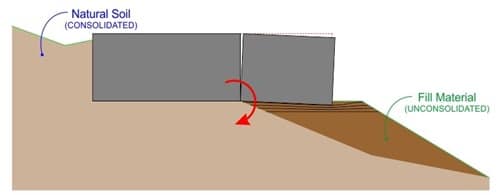
Machinery Foundations
Generally, machinery foundations need to be designed to distribute the load of placed machineries onto the ground in order to avoid too much settlement or tilting of foundation relative the floor or other fixed objects.
Proportioning of foundation base, which support non-vibrating loading, can be easily conducted provided that soil compressibility and shear strength is known.
The permitted bearing pressure to avoid excessive settlement can be estimated and tilting may be eliminated by placing machinery center of gravity on that of foundation block.
Foundation vibration may come from outside source such as earthquake or objects which are supported by foundations such as machinery.
As far as the latter issue is concerned, it is advised to prevent the coincidence between machine operating frequency and foundation natural frequency. This because the movement would greatly amplify due to resonance condition.
If the machine operates over wide range of frequencies, then it is recommended to test the influence of resonance effect on the foundation movement to check whether it is within acceptable limit or not.
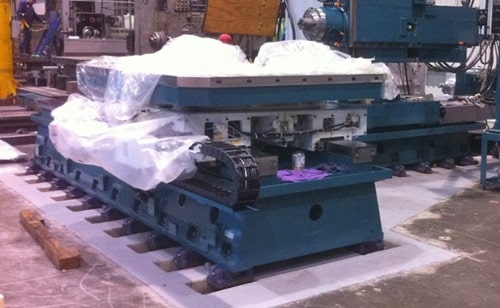
Measures used to decline vibration influence is the increase of foundation mass to attenuate reflection within the foundation. Added to that, mountings can be employed to decay vibrations if the construction of heavy foundation is not practical.
Different mountings used to absorb vibrations include cork slab and rubber pads, rubber carpet mountings, bonded rubber mountings, and leaf springs.
Comments
Vibration Damping Sandwich Mounts